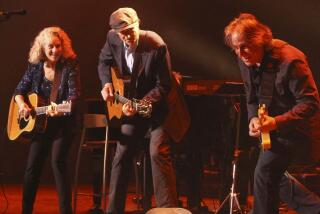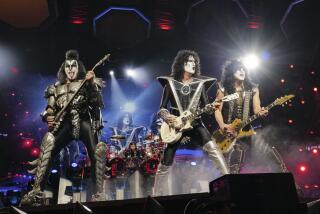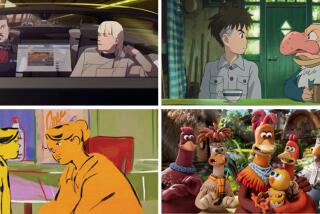Animated Pop Band Takes to the Stage
“I’m useless, but not for long,” a voice from behind a giant video screen declared during Gorillaz’s sold-out concert Friday at the Hollywood Palladium. “My future is coming ... I’m happy.”
The line is from “Clint Eastwood,” the most popular track on Gorillaz’s self-titled 2001 hit album--and it’s easy to look at the words as a battle cry for this unusual pop enterprise.
In Gorillaz, the project’s creators, chiefly singer-songwriter Damon Albarn and artist-animator Jamie Hewlett, are poking fun at pop-rock convention.
With the music and image of so many pop artists these days being manufactured by hired songwriters and producers, Albarn and Hewlett figured they’d put together the ultimate hollow act: a cartoon quartet that exists only on the video screen.
One way, then, to look at the “Clint Eastwood” lyric is that it’s today’s pop-rock experience that is useless. And that a happier future is just a little imagination away.
With Gorillaz, Albarn and Hewlett attempt to supply that imagination.
In the project, Albarn and some friends, notably dance-world record producer-conceptualist Dan “the Automator” Nakamura, supply the music, which blends everything from Clash-era rock to electronica, hip-hop and a touch of reggae. Hewlett, best known for the British comic strip “Tank Girl,” oversaw the animation.
It’s a gimmick that caught the pop world’s ear on record, and the Gorillaz concert tour maintains the joke by having Albarn, Nakamura and other musicians perform in anonymity behind the screen. The only thing the audience sees is videos of the cartoon band.
It is a concept that is part MTV and part Cartoon Network, and in the idea-starved rock world it’s enough to make the live show one of the year’s most anticipated.
On the way into the Palladium, where Gorillaz sold out two nights, fans in line were asking one another lots of obvious questions:
Would musicians really be playing behind the screen? Would the music just be on tape? Would it matter?
There has been lots of exaggerated visual emphasis in rock’s past, including the psychedelic light shows of the ‘60s, which worked mainly because most of the audience was stoned. Yet even back then the musicians were visible on stage.
There’s a sweet edginess to these four cute characters, who are like an older, rock ‘n’ roll version of the gang in “South Park.” The leader is 2D, a likable takeoff on the classic pretty-boy lead singer. Murdoc is a moody, mysterious guitarist in the Keith Richards tradition; Noodle is the band’s female member; and Russel is the hip-hop component.
At the start of Friday’s show, all four appeared in a small cartoon on a screen high above the stage. As the music began, the image grew until it filled the top half of the huge screen. In the bottom were the shadowy outlines of the musicians at work.
The music doesn’t offer the songwriting sophistication of Beck, the soulfulness of Moby or the sonic thrill ride of the Prodigy, to cite three rival cross-cultural navigators. Still, it is solid, invigorating stuff, from the high-energy dance-rock mix of “M1 A1” to the moody dreamscape of “Tomorrow Comes Today.”
Far less winning Friday were the mostly flat and uninvolving visuals. The biggest surprise was how little the characters were featured. Rather than follow them on some interesting exploits, the show simply put them through generic paces or ignored them altogether in favor of flashing images that could have fit into old psychedelic light shows.
The most amusing aspect of the hourlong set was that you found yourself so bored with the visuals that you kept straining to see the band members through the screen.
While walking around the ballroom near the end of the show, I came across a TV monitor on the soundboard that enabled the engineers to see the musicians. Albarn, leader of the English rock group Blur, and his cohorts were jumping around energetically, just the way they would if they were in front of the screen.
There was an almost sweet innocence about their enthusiasm, and it was a reminder of the importance of the emotional connection between performer and fan. The odds are Gorillaz could have gotten the loudest response of the night by simply lifting the screen and letting everyone see the musicians at work.
Without that, Albarn and the others seemed prisoners of their own creation. It may be too harsh to call the Gorillaz stage show useless, but it was far from an enticing door to rock’s future.
More to Read
The biggest entertainment stories
Get our big stories about Hollywood, film, television, music, arts, culture and more right in your inbox as soon as they publish.
You may occasionally receive promotional content from the Los Angeles Times.










